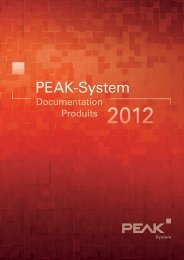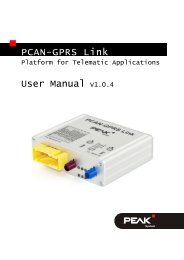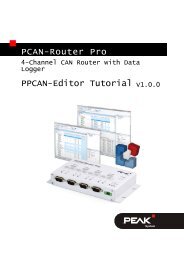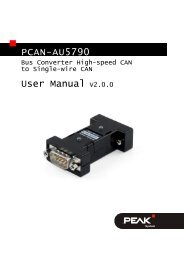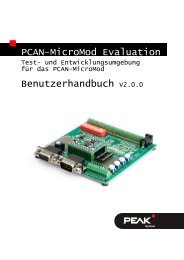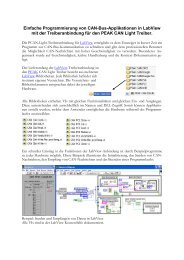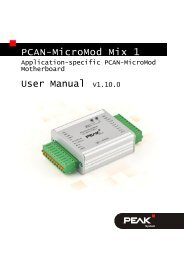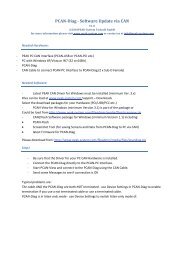PCAN-MicroMod CANopen - User Manual - PEAK-System
PCAN-MicroMod CANopen - User Manual - PEAK-System
PCAN-MicroMod CANopen - User Manual - PEAK-System
Create successful ePaper yourself
Turn your PDF publications into a flip-book with our unique Google optimized e-Paper software.
<strong>PCAN</strong>-<strong>MicroMod</strong> <strong>CANopen</strong> - <strong>User</strong> <strong>Manual</strong><br />
4 <strong>CANopen</strong>® Implementation<br />
The implementation features the major <strong>CANopen</strong> services as standardized<br />
in the following CiA documents:<br />
CiA® 301 “<strong>CANopen</strong> Application Layer and Communication<br />
Profile” version 4.02<br />
CiA® 401 “<strong>CANopen</strong> Device Profile for Generic I/O Modules”<br />
version 2.1<br />
In summary, these services are:<br />
One SDO server giving <strong>CANopen</strong> Managers and configuration<br />
tools access to the internal Object Dictionary (OD)<br />
Heartbeat Producer functionality allowing the devices to<br />
produce their individual heartbeat messages at a configurable<br />
rate<br />
Heartbeat Consumer functionality with up to three channels<br />
allowing the monitoring of up to 3 heartbeats<br />
Although not recommended to be used, the Node Guarding<br />
functionality is still implemented in order to be compatible with<br />
legacy devices<br />
Emergency Producer to inform other nodes over major error or<br />
other emergency situations<br />
Re-configuration of Node ID and bit rate during operation<br />
Storage of configuration parameters in non-volatile memory<br />
4 Receive Process Data Objects (RPDO) with dynamic<br />
communication and mapping parameters – RPDO configuration<br />
including CAN message ID used and contents mapped to the<br />
RPDO can be changed during operation<br />
22



![English - Low Quality [7.2 MB] - PEAK-System](https://img.yumpu.com/5931738/1/184x260/english-low-quality-72-mb-peak-system.jpg?quality=85)
